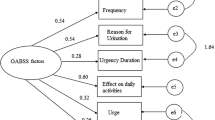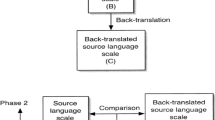Abstract
Introduction and hypothesis
This study aimed to translate and validate the 8-item overactive bladder questionnaire (OAB-V8).
Methods
Utilizing a multistep process, the English version of the OAB-V8 was translated into Arabic by three urologists and one independent translator. It was validated by asking 46 patients with overactive bladder and 58 healthy individuals to complete the questionnaire. Healthy individuals were involved in establishing the discrimination validity. The scores of both groups were compared using the Mann-Whitney test. The reliability of the Arabic version was evaluated utilizing Cronbach’s alpha test for internal consistency. Spearman’s correlation coefficient (r) was utilized to evaluate the domain structures and the inter-domain associations.
Results
Internal consistency was high (Cronbach’s alpha = 0.923). There were good correlations among frequency, urgency, sudden urge to urinate, waking up at night to urinate and uncontrollable urge to urinate. There were weak or no correlations among urge, incontinence and nocturia. For discrimination validity, there were significant changes in all domain scores when comparing patients with ureteric stents and healthy individuals (P < 0.001).
Conclusions
The Arabic version of the OAB-V8 proved to be a reliable and valid tool, which can be easily utilized to evaluate symptoms in Arabic patients. It is feasible in evaluating quality of life in relation to this disorder, as patients are able to demonstrate their symptoms accurately with the comfort of their first language, Arabic.
Similar content being viewed by others
References
Abrams P, Cardozo L, Fall M, et al. The standardisation of terminology in lower urinary tract function: report from the Standardisation Sub-committee of the International Continence Society. Urology. 2003;61:37–49.
Irwin DE, Kopp ZS, Agatep B, et al. Worldwide prevalence estimates of lower urinary tract symptoms, overactive bladder, urinary incontinence and bladder outlet obstruction. BJU Int. 2011;108:1132–8. https://doi.org/10.1111/j.1464-410X.2010.09993.x.
Durden E, Walker D, Gray S, et al. The economic burden of overactive bladder (OAB) and its effects on the costs associated with other chronic, age-related comorbidities in the United States. Neurourol Urodyn. 2018;37:1641–9. https://doi.org/10.1002/nau.23513.
Kinsey D, Pretorius S, Glover L, Alexander T. The psychological impact of overactive bladder: a systematic review. J Health Psychol. 2016;21:69–81. https://doi.org/10.1177/1359105314522084.
Chiaffarino F, Parazzini F, Lavezzari M, et al. Impact of urinary incontinence and overactive bladder on quality of life. Eur Urol. 2003;43:535–8.
Coyne K, Revicki D, Hunt T, et al. Psychometric validation of an overactive bladder symptom and health-related quality of life questionnaire: the OAB-q. Qual Life Res. 2002;11:563–74.
Diokno A, Lee P, Zorn BH, et al. Factors associated with clinical assessment of overactive bladder and selection of treatment. Clin Ther. 2001;23:1542–51.
Shaw C, Tansey R, Jackson C, et al. Barriers to help seeking in people with urinary symptoms. Fam Pract. 2001;18:48–52.
Guillemin F, Bombardier C, Beaton D. Cross-cultural adaptation of health-related quality of life measures: literature review and proposed guidelines. J Clin Epidemiol. 1993;46:1417–32.
Coyne KS, Zyczynski T, Margolis MK, et al. Validation of an overactive bladder awareness tool for use in primary care settings. Adv Ther. 2005;22:381–94.
Reilly K, McKown S, Gawlicki M, Coyne K. PUK24 linguistic validation of the overactive bladder questionnaire (OAB-Q), overactive bladder short form questionnaire (OAB-Q SF), OAB assessement tool (OAB-V8) in 4 languages. Value Health. 2006;9:A391–2. https://doi.org/10.1016/S1098-3015(10)63791-6.
Brenes FJ, Angulo JC, Ochayta D, et al. Psychometric validation of the OAB-V8 and OAB-V3 scales for the screening of patients with probable overactive bladder in the Spanish population. Med Clin (Barc). 2014;143:521–9. https://doi.org/10.1016/j.medcli.2013.10.032.
Peterson AC, Sehgal A, Crump RT, et al. Evaluating the 8-item overactive bladder questionnaire (OAB-v8) using item response theory. Neurourol Urodyn. 2018;37:1095–100. https://doi.org/10.1002/nau.23420.
Coyne KS, Tubaro A, Brubaker L, Bavendam T. Development and validation of patient-reported outcomes measures for overactive bladder: a review of concepts. Urology. 2006;68:9–16. https://doi.org/10.1016/j.urology.2006.05.042.
El-Nahas AR, Elsaadany MM, Tharwat M, et al. Validation of the Arabic linguistic version of the ureteral stent symptoms questionnaire. Arab J Urol. 2014;12:290–3. https://doi.org/10.1016/j.aju.2014.08.001.
Author information
Authors and Affiliations
Corresponding author
Ethics declarations
Conflicts of interest
None
Additional information
Publisher’s note
Springer Nature remains neutral with regard to jurisdictional claims in published maps and institutional affiliations.
Appendix
Appendix
Rights and permissions
About this article
Cite this article
Al-Shaiji, T.F., Alkabbani, M., EL-Nahas, A.R. et al. Validation of the Arabic linguistic version of the 8-item overactive bladder questionnaire (OAB-V8). Int Urogynecol J 30, 2153–2156 (2019). https://doi.org/10.1007/s00192-019-03905-0
Received:
Accepted:
Published:
Issue Date:
DOI: https://doi.org/10.1007/s00192-019-03905-0




